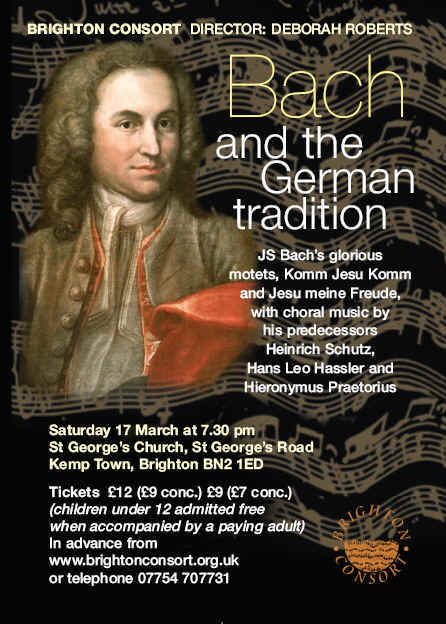Bach and the German Tradition

Venue:St George's Church, Kemptown, Brighton
More information
Concert Programme
Hans Leo Hassler (1564 - 1612) - Dixit Maria
Hieronymus Praetorius (1560 - 1629) - Magnificat
Heinrich Schutz (1585 - 1672) - Es ist erschienen and Die mit Traenen saen
Johann Sebastian Bach (1685-1750) - Komm Jesu Komm
INTERVAL
Hassler - Ad dominum cum tribularer
Heinrich Schutz - Ich bin eine rufende Stimme and Selig sind die Toten
Bach - Jesu meine Freude
Programme notes
In the two main programmes that Brighton Consort are presenting this year we are focusing on the work of two of the principal and most influential composers from the pre Classical world: Josquin des Pres from the Renaissance, and JS Bach from the Baroque eras. With Josquin (the subject of our next concert on April 28th in St Mary the Virgin church) we will be looking forward in time to show his influence on the next generation of composers. With Bach we are doing the reverse. Many studies have been made of the huge impact that Bach made on the history of Western music, but as we are a choir that specialises in music from the Renaissance and early Baroque, it seems fitting that we should look at the tradition that Bach was building on in the music of previous generations. The other composers featured this evening were all dead by the time Bach was born, but it is none the less fascinating to perceive Bach's links with this 17th century world, one in which German music was beginning to find its own voice.
Hieronymus Praetorius (1560 - 1629) was not in any way related to the better known Michael Praetorius, though the two composers probably met in 1596. To add to the confusion Hieronymous had a composing son also called Michael, but he died in 1619, ten years before his father. Despite spending most of his life in Hamburg, and not travelling abroad to study Hieronymous was one of the first North German composers to master the Venetian polychoral style, composing Latin masses, motets and other litugical works in several choirs in the manner of the Gabrielis. The Italian style was also evident in the expressive way he set words, his use of dynamic rhythms and chromatic harmony, but he also wrote German works that use traditional melodies and chorals. Of the nine magnificat settings that he wrote, the one that we are performing tonight originally concluded with 8 voice versions of German texted Christmas carols.
Hans Leo Hassler (1564 - 1612) was born in Nuremberg in the South of Germany, to this day still a Catholic region. Educated first by his musical father, he was later sent to Venice where he studied alongside Giovanni Gabrieli under his uncle, Andrea. A protestant himself, Hassler was the write extensively for both churches, and many of his melodies are now among the most familiar of church chorales made famous by JS Bach in his Passions. As the first major German composer to study in Italy, he shares with Praetorius the role of developing the modern Italian style in Germany. Many of his early works in particular are highly experimental, using chromatic techniques absorbed during his time of study with Gabrieli. Like Praetorius he also wrote several polychoral works in both Latin and German, though his later style tends to be more conservative in the manner of Palestrina.
Beyond Bach, Heinrich Schutz (1585 - 1672) is probably the most familiar name among tonight's featured composers. Like the older Hassler he also studied in Venice, but this time with Hassler's erstwhile fellow pupil, Giovanni Gabrieli. After six years in Venice Schutz returned to Germany and was shortly after appointed court composer to the Elector of Saxony at the court of Dresden, a position previously held by Hassler. The Thirty Years War in Germany disrupted the court life and Schutz spent several years abroad: in Venice again where he met Monteverdi, and also a period of time in Copenhagen, but retained his Dresden post until his death at the age of 87.
The blending of European styles that had begun with the music of Praetorius and Hassler reaches a new height in the works of Schutz. Greatly influenced by Monteverdi, his whole output, including many works for solo voices as well as polychoral and even madrigalian compositions, shows a wonderful attention to the emotional content of words, be they in Latin, Italian or German. All of the German motets performed this evening are taken from his Geistliche Chor-Music of 1648. Although his German oratorios such as the Passion settings may link him most strongly with Bach, these exquisite motets illustrate most strongly the total synthesis of the Italian style into German music that was to help develop the lyricism that flows through Bach's works.
JS Bach himself, so often described as the father of German music, certainly had several 'fathers' of his own through which to build his undefinable style. Although he never left Germany he was to draw together the expressivity of the Italian style with the elegant dances of the French and produce something that can only be himself, recognisable within seconds.
Deborah Roberts